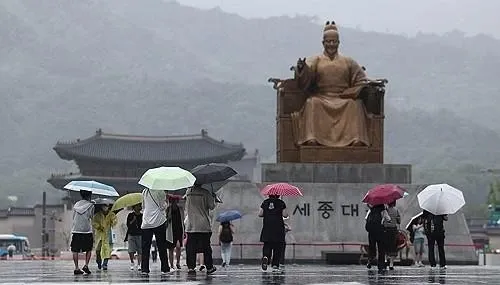Why is South Korea on High Alert for Heavy Rain?

Synopsis
Key Takeaways
- Severe rain expected across South Korea
- 150 mm of rainfall forecasted in southern areas
- Emergency response systems activated
- Residents urged to stay informed
- Potential wind gusts exceeding 20 m/s
Seoul, Aug 3 (NationPress) A significant weather alert has been issued as heavy rain is anticipated to impact the majority of South Korea on Sunday, with forecasts predicting rainfall of up to 150 millimeters in southern regions until Tuesday, according to the state meteorological agency.
The rain is set to initiate in the southwestern provinces and Jeju during the day, gradually extending to southeastern and central areas before enveloping most parts of the nation, excluding regions along the East Sea, as reported by Yonhap news agency, citing the Korea Meteorological Administration (KMA).
Continuing through Tuesday, the rainfall could reach as high as 150 mm in southern locales, including the port city of Busan. The administrative city of Sejong and other central areas are projected to receive up to 100 mm of rain.
Particularly intense downpours, ranging from 50 to 80 mm per hour, are expected overnight in specific southern coastal regions of South Jeolla Province, around Mount Jiri, and in the mountainous areas of Jeju, the agency noted.
Additionally, strong winds are predicted for the western coast of South Jeolla Province, with gusts potentially exceeding 20 meters per second later in the day.
To prepare for the anticipated heavy rains, the agricultural ministry has activated a 24-hour emergency response system in collaboration with local governments and pertinent agencies. Efforts have been intensified in areas susceptible to floods and landslides.
Earlier in the day, South Gyeongsang Province elevated its emergency response level to Level 1, following the issuance of a preliminary heavy rain advisory for parts of its territory.
Heavy rainfall is particularly expected to affect southern coastal areas and regions surrounding Mount Jiri, which experienced substantial damage during the torrential rains in July, heightening concerns about additional damage.
North Jeolla Province also activated a Level 1 emergency response system after a preliminary heavy rain advisory was issued for ten cities and counties within the province.
A local government official stated, "Residents are encouraged to stay updated on weather conditions, minimize unnecessary outings, and avoid hazardous areas such as riverside trails, slopes, and low-lying roads. Beachgoers and campers should take care and evacuate in advance if necessary."
Last month, South Korea faced severe rainfall and landslides that resulted in 23 fatalities and left five individuals unaccounted for nationwide.
As the rains approach, heat wave advisories are expected to be gradually lifted or eased.
Daytime temperatures will range between 29 and 34 degrees Celsius, which is similar to or slightly above seasonal norms, according to the KMA.









